December 2018 included an eclectic variety of productions in Copenhagen, Denmark, since the late fall/winter theatre seasons seem to flourish during the long, dark nights in Scandinavia. Copenhagen has a diverse theatre, music and art scene that is strongly related to the country’s rich history as a major European power despite its relatively small geographic size. With only around four million inhabitants, Denmark strives to make sure that all citizens have access to the many forms of artistic expression including access to performances as well as training and education in the arts. Given the fact that there are only around eleven state-supported theatre companies in Denmark – in addition to the fact that only one, the Danish National Theatre, is fully funded – Denmark makes every effort to bring high quality artistic expression to all citizens of Danish society. The state theatre system of Denmark, fueled by the strongly coordinated state training system, guarantees the development of a recurring successful pool of potential employees in the system but at the same time identifies the most qualified participants and allows only them the ability to participate in the creation of dramatic art in the National System.
Central to the Danish theatre system is the Danish National Theatre School of the Performing Arts. Located in the Christianshavn area of Copenhagen, the university has a highly selective entrance process that admits only a small percentage of qualified applicants to study for a period of three years tuition free in the university. According to Senior Professor of the Danish National School of Performing Arts Mette Borg, around twenty-one students from around two thousand applicants are accepted into the acting program (spread among three separate campuses) with similar numbers accepted into programs in Music Theatre / Opera, Physical Theatre, Technical Theatre and Film. The program is kept highly selective and small due to the size of the country and the number of potential employment positions eventually available. Only around five hundred students (including a substantial number of international short term students) are enrolled at the Danish National School of the Performing Arts during any academic year. The Danish National School of the Performing Arts is relatively new, though the Danish National School of Music, a separate university and campus, has provided many performers, musicians and dancers for several decades.
Denmark has only one truly state supported theatre—the Royal Danish National Theatre, which includes the Danish National Theatre, the Danish National Opera, the National Symphony and the Danish National Ballet as well as training programs in ballet, opera and theatre. The National Theatre and its constituents are all funded through the Danish National Ministry of Culture. According to Ministry of Culture representative Ane Kathrine Lærkesen, the yearly funding for the Royal Danish National Theatre is five hundred million (half a billion) Danish Kronas (DKK). While that amount falls short of other major European countries such as France, Germany and Norway, it clearly speaks to the goal of Denmark to support the arts at a very high level. Clearly the Royal Danish National Theatre receives the bulk of national funding, yet around eleven regional theatre companies and numerous other performing arts companies receive up to ten million DKK in yearly funding to present performing arts presentations across the country. As a company devoted primarily to touring presentations of theatre on a national level, the Folketeatret receives a slightly higher level of funding due to the company’s level of commitment to presentation of works throughout the country of Denmark. More about this company will be presented later. All in all, Denmark’s theatre system represents a balance of various styles of performance that present the Danish public with a strong array of performing arts options at a reasonable price.
The Betty Nansen Teatret is a long-standing theatre company in the Fredericksborg area of Copenhagen that is named after one of the major actresses in the history of Danish Theatre. One need only visit one of the many pubs around the theatre to realize the historical importance of the theatre. Kat på et Varme Bliktag (Cat on a Hot Tin Roof) was presented as part of the Fall 2108 season. Directed by Minna Johannesson and designed by Christian Friedländer, the production was characterized by numerous elements relating to the themes of sex and barrenness. Sexy music was played by onstage musical director and pianist Mikkel Hess throughout the performance that featured naked performers in the bathtub and elsewhere with dressing/undressing onstage and design images that reflected themes of desert and wasteland. The production emphasized the lack of sexuality between Maggie and Brick while revealing both as figures of beauty as both appeared naked for nearly a quarter of the production.
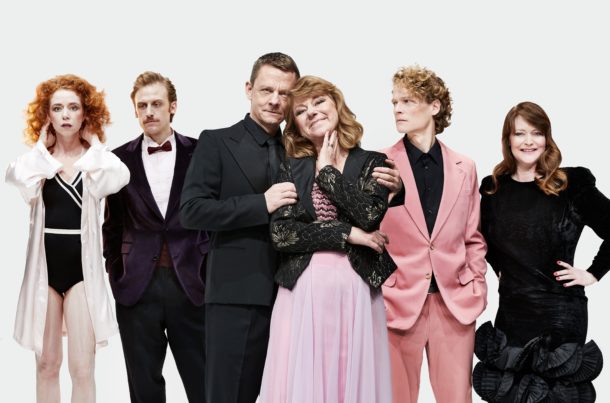
The company of Cat on a Hot Tin Roof. Photo credit: Betty Nansen Teatret.
Key elements of the production began with the setting in the smaller 500-seat house. The scenic design was comprised of a unit set that would represent all of the many locations demanded by the script. Scenic designer Friedländer constructed an environment that included a musician (defined by his own playing space that was continuous throughout the production) and numerous cacti (obviously meant to symbolize the sexual “desert” or sterility in the relationship of Brick and Maggie). The landscape was also inclusive of the musical area as well as various spaces, fluid and used as needed in the production.
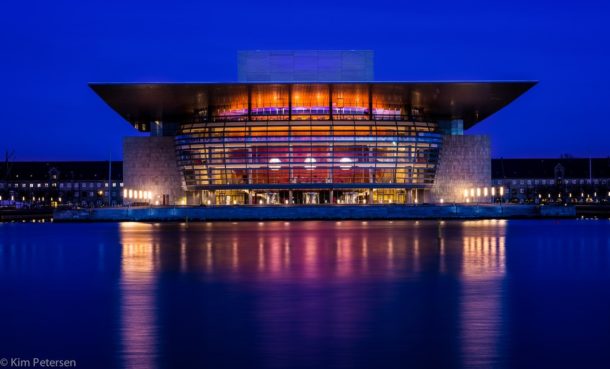
Operean in Copenhagen, Denmark. Photo Credit: Kim Petersen.
The Royal Danish National Opera performs in Operaen, the National Opera House, built in 2005 by a private trust created by legendary shipping magnate Maersk Mc-Kinney Møller. One of the most expensive opera houses built in contemporary times, Operaen seats around 1700 and features a unique architectural style described as “neo-futuristic.” Included in the repertory during December 2018 was Puccini’s La Bohème, directed by Elisabeth Linton. Featuring a cast of many graduates from both the Royal Danish Academy of Music as well as the Danish Academy of Performing Arts, La Bohème was given a lavish contemporary staging and utilized a non-period specific contemporary design. The direction and design highlighted the incredible technical capabilities of the theatre and were clearly the strongest elements of the production. The Danish National Symphony provided perhaps the strongest orchestra an opera could desire, as the entire event managed to reach the necessary scale realized by the major opera houses of Europe. A major weakness in the production, however, lay in the approach to the training of actors of sung theatre in Denmark. According to both instructors as well as students at the Danish National School of Performing Arts, very little attention is given to the details of acting in the training of opera performers at both the Danish National School of Performing Arts as well as at the Danish National School of Music, as the bulk of training focuses on voice and musicianship. Only after formal training has ended and the graduates are placed in the company are they given a two-year course that extends their training and includes several seminars in acting. This key weakness in the training was particularly noticeable in the roles of Rodolfo (Niels Jorgen Riis) and Marcello (David Kempster). Neither actor seemed grounded on stage and appeared to be somewhat “lost” in several moments; not at all connected to the dramatic action of the scenes. It was the basic problem of actors standing on stage and singing properly as opposed to playing a role in a scene in a story and singing properly.
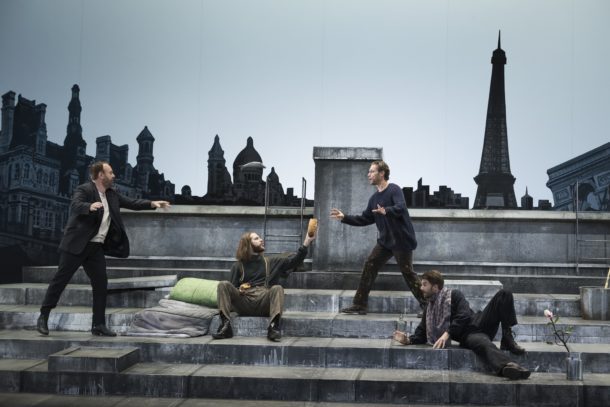
La Bohème. Photo credit: Danish National Opera.
The Royal National Ballet performs primarily in the National Theatre Old Stage, a majestic building erected in Kongen’s Nytorv just a few blocks from Amalienborg Palace. Directed by David Briskin and Choreographed by Christopher Wheeldon, Alice in Wonderland displayed the incredibly strong focus of the Royal Danish School of Ballet (connected with the Danish National School of Music) on technique for world dancers, as the dance technique in this production revealed a level of production and training that is not often seen. It is well known that Danish society has advanced ballet for decades and my impression is that much success has been achieved. I have not seen a larger group of strong male ballet dancers than I have in Alice in Wonderland. It was as if an NFL team somehow appeared on the field/stage. The grounding of the production with a strong male presence combined with the flair and grace of the female corps de ballet made for an incredibly strong story-based ballet.
The scenic design and staging of Alice in Wonderland was provided by a strong cadre of master artists, including set designer Nicholas Wright, lighting designer Natasha Katz, projection designers Jon Driscoll and Gemma Carrington and other properties and puppet designers Toby Olie, Jakob Nystrup and Paul Kieve. Basically the production was a restaging of the 2013 Royal Ballet Production also directed and choreographed by Wheeldon. Given the nature of the story, the scenic design for Alice in Wonderland was incredibly challenging, but several locations – generally not highlighted in most productions of the story – were featured. Among these was the sausage factory that came into play in the story just before the Duchess’ trial. The scenes in the factory were fittingly gruesome. Bodies of both humans and animals were fed through the grinders as the nature of the ballet tended toward darkness and violence. Other scenes involving the Queen of Hearts played by Kizzy Matiakis were truly stunning as brilliant scenes of violence. The queen went to extraordinary depths in order to maintain her primacy in the “game” as displayed in the ballet.

Sausage factory in Alice in Wonderland. Photo credit: Danish National Ballet.
The National Theatre of Denmark presents plays in two new locations in the newly constructed Storekassen, an extraordinary theatrical complex located in the Nytorv Harbor area of Copenhagen. Kongens Fald (The Fall of the King) a Nobel Prize winning novel by Johannes Jensen, was presented in dramatic form during Fall 2018. As elsewhere in European theatre, the presentation of novels on stage has become common in Denmark; however, it has presented problems for audiences as the scale of novels challenges audiences with regard to the perception of the stories. This was certainly the case with Kongens Fald. Directed by Carlus Padrissa, artistic leader of the Catalonian Theatre group La Fura dels Baus, Kongens Fald tells the story of Mikkel Thogersen, a dreamy, nonchalant student who eventually finds service as a mercenary under King Christian II of Denmark. The expansive story was realized in the incredibly well equipped Storekassen, one of the most beautiful European theatres I have ever seen. Since the plot required several extensive travel scenes (many by travel on water) numerous boat and water scenes were included in the production. These were achieved by incredible scenic technology that included video film projection accompanied by the physically realized water vessels (several) that where created by various 3-Dimensional set pieces that were both flown in as well as brought from the offstage areas. Offstage wind machines were also employed, yielding realistic onstage sea scenes that included wind, waves and torrential rain conditions.
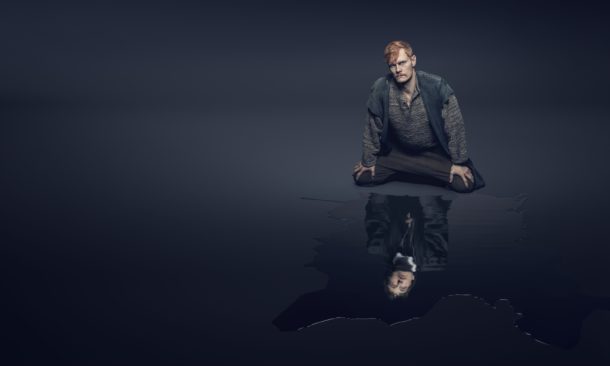
Joen Hojerslev as Mikkel Thorgersen in Kongens Fald. Photo credit: The National Theatre of Denmark.
Det Ny Teater is another large proscenium house that has, throughout its long history, challenged the Royal Danish National Theatre as the most prominent theatre in Denmark. Built in 1908 in the heart of Fredericksborg, Det Ny is a private producing operation that receives a noticeable subsidy from the Ministry of Culture. The twenty-first century has seen several fairly long-running productions at the venue but none more successful than The Phantom of the Opera, which has been produced at the theatre three times from 2000 – 2002, 2008 – 2010 and now 2018 – 2020. Given the unique nature of the Det Ny architecture, often described as a cross between Art Deco and trompe l’œil with the addition of Greek columns, Det Ny’s unique location is a perfect venue for a production of The Phantom of the Opera. In fact, the building, completed in 1907 by Ludvig Anderson after a number or construction disputes, was ultimately based on the theatre of the Paris Opéra, the original setting for Phantom.
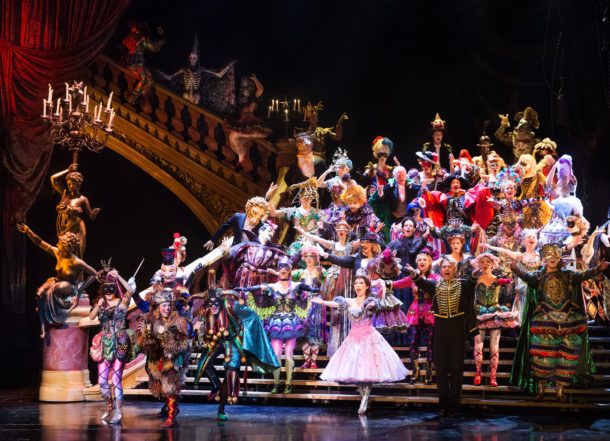
Company of Phantom of the Opera. Photo credit: Det Ny Theater.
In Copenhagen, Phantom was staged by Arthur Masella, longtime collaborator with both the U.S. and London versions of the production that were directed by Harold Prince. The Danish reiteration of the London, and later, Broadway production, was generally a complete restaging of the original London production with just a few changes made in order to accommodate the slightly smaller proscenium stage width of the Det Ny Teater as opposed to Her Majesty’s Theater in London. The theater felt considerably smaller, especially as far as width is concerned. However the Danish production at Det Ny was completely successful and the many technical requirements of the production were well achieved. Both John Martin Bergtsson and Sibylle Glsted were fantastic as the Phantom and Christine, while Christian Lund seemed a young apprentice in the role of Raoul. Overall the production of Phantom at Det Ny was highly successful and the quality of the company’s work coupled with the unique style of the theatre would make it a certain destination for those wishing to see theatre in Denmark.
Perhaps the most important theatre company in Denmark is the Folkteatret, a “grass roots” theatre company whose mission is simply to “present theatre to the people.” The level of national funding for the company falls into the range of the eleven million DKK that the bulk of state supported theatres in Denmark receive, but the company’s mission of touring productions across Denmark and other territories (including the Faroe Islands and other outlying islands associated with Denmark) gains the company additional funding from the Danish Ministry of Education as well as a few corporate sponsors – a trend that has surfaced in Denmark during the last two decades (the Maersk grant being the most significant in 2005). The Folkteatret presented Peer Gynt in their smaller space in the Nyhovn Arts district to a sold-out audience in the black box theatre that seated around 250 patrons.
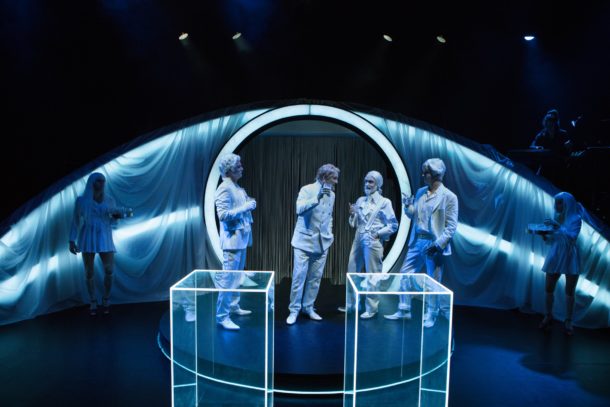
Peer Gynt. Photo credit: Folketeartret Denmark.
Peer Gynt is an expansive story with a plot that extends over thirty years. Given the small space at the Folkteatret black box, director Henriette Vedel adopted a Brechtian approach to the staging that included video and slides to advance and make commentary on the action. Another Brechtian element was the inclusion on the stage of all costumes from the many characters in the story hanging on various lines on either side of the center stage “door” area. Given this format, actors could change costumes quickly to perform the many roles of the story; therefore, all costume changes took place on stage, sometimes with help from assistants, while the narration of the story – a key element in this production – took place. Vedel chose to include elements of narration in the production
Finally, Tivoli Gardens amusement park is one of the most magical sites in Copenhagen, especially given the incredible Christmas decorations displayed in the park during the winter season. The Tivoli Concert Hall and Music Theatre presented Fogg’s Off, a retelling of the Jules Verne story Around the World in Eighty Days in an updated, contemporary setting. Directed and produced by Vivien McKee, whose name was mentioned relentlessly throughout the production, Fogg’s Off played to an enthusiastic sold-out audience at the fantastic re-envisioning of a London Music Hall in Denmark by many very clever English investors. Fogg’s Off was a winter musical production that was geared to address contemporary political issues and ideas. Vladimir Putin was the most admonished leader – his ideas regarding the finance campaign were chastised. Donald Trump was hardly mentioned, which was somewhat surprising. The production was a musical revue that mostly looked at policies in Europe during the 2018-2019 season and the main European influences (such as BREXIT and other EU issues) that involve the system. Musical numbers, movement and pantomime scenes were all included in this work, but the primary characteristic was close audience involvement, as Fogg’s Off encouraged rapport with the cast, sing along sequences, voting via applause and other conventions used to engage audience participation.
The Danish Theatre System clearly reflects the European model of strong state support supplemented by growing private funding and increases in box office relaince. Copenhagen represents the bulk of Danish theatre production but cities such as Aarhaus and Ifland are not lacking theatre productions, and the Faroe Islands have also had a strong tradition of theatrical performance for the past several decades. All said, the theatre of the Danish territories was functioning at a high rate in 2018. The development of a truly civilized nation with strong artistic output was evident during my visit in December 2018.
Steve Earnest is a Professor of Theatre at Coastal Carolina University, having received a PhD in Theatre from the University of Colorado, Boulder and an M.F.A. in Musical Theatre from the University of Miami, Florida. Dr. Earnest has published articles, reviews and interviews in Theatre Journal, Western European Stages, Backstage West, Ecumenica, The Journal of Beckett Studies, Theatre Symposium, New Theatre Quarterly, and Theatre Studies, among others. In 1999 he published a book entitled The State Acting Academy of East Berlin and is currently working on projects dealing with the theatre system of Iceland.

European Stages, vol. 13, no. 1 (Spring 2019)
Editorial Board:
Marvin Carlson, Senior Editor, Founder
Krystyna Illakowicz, Co-Editor
Dominika Laster, Co-Editor
Kalina Stefanova, Co-Editor
Editorial Staff:
Joanna Gurin, Managing Editor
Maria Litvan, Assistant Managing Editor
Advisory Board:
Joshua Abrams
Christopher Balme
Maria Delgado
Allen Kuharsky
Bryce Lease
Jennifer Parker-Starbuck
Magda Romańska
Laurence Senelick
Daniele Vianello
Phyllis Zatlin
Table of Contents:
- Introductory Note by Kalina Stefanova.
- “Andrzej Tadeusz Wirth (1927 – 2019) – White on White” by Krystyna Illakowicz.
- Lithuanian Marriage in Warsaw or The Last Production of the Great Eimuntas Nekrošius by Artur Duda.
- “My, Żydzi polscy [We, Polish Jews]”: A Review of Notes from Exile by Dominika Laster.
- A Report on the State of Our Society, According to Jiří Havelk in The Fellowship of Owners at VOSTO5, Prague, and Elites, at the Slovak National Theater, Bratislava by Jitka Šotkovská.
- About Life as Something We Borrow. On the Stages of Pilsen (In the 26 th edition of the International Theatre Festival There) by Kalina Stefanova.
- Redesigning Multiculturalism or Japanese Encounters in Sibiu, Romani, The Scarlet Princess, written and directed by Silviu Purcărete, inspired by Tsuruya Namboku IV’s Sakura Hime Azuma Bunshô by Ion M. Tomuș.
- About Globalization: A “Venice Merchant” on Wall Street, at the Hungarian Theatre of Cluj in Romania by Maria Zărnescu.
- The Patriots, Mary Stuart and Ivanov and the Rise of the Drama Ensemble of the National Theatre in Belgrade by Ksenija Radulović.
- The Unseen Theatre Company or How to See Beyond the Visible: The Shadow of My Soul and the Theatre of Velimir Velev by Gergana Traykova.
- Multilingual Pirandello, Understandable to Everyone: The Mountain Giants at the Croatian National Theatre “Ivan pl. Zajc”, Rijeka by Kim Cuculić.
- The return of the repressed: the ghosts of the past haunt Barcelona’s stages by Maria M. Delgado.
- A poetics of memory on the Madrid stage (2018) by Maria M. Delgado.
- The Danish National Theatre System and the Danish National School of Performing Arts: December in Copenhagen 2018 by Steve Earnest.
- Towards a Theatre of Monodrama in Turkey 1 by Eylem Ejder.
- Where Is Truth? Justiz by Friedrich Dürrenmatt, adapted and directed by Frank Castorf at the Schauspielhaus Zürich by Katrin Hilbe.
- Report from Vienna by Marvin Carlson.
www.EuropeanStages.org
europeanstages@gc.cuny.edu
Martin E. Segal Theatre Center:
Frank Hentschker, Executive Director
Marvin Carlson, Director of Publications
©2019 by Martin E. Segal Theatre Center
The Graduate Center CUNY Graduate Center
365 Fifth Avenue
New York NY 10016
European Stages is a publication of the Martin E. Segal Theatre Center ©2019
Martin E. Segal Theatre Center:
Frank Hentschker, Executive Director
Marvin Carlson, Director of Publications
©2019 by Martin E. Segal Theatre Center
The Graduate Center CUNY Graduate Center
365 Fifth Avenue
New York NY 10016
European Stages is a publication of the Martin E. Segal Theatre Center ©2019



